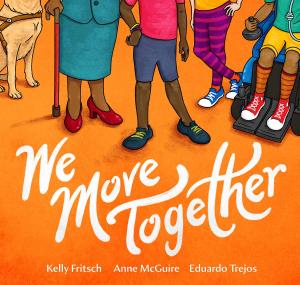
We Move Together
Every now and then something special comes along that reignites a certain love of books in a teacher. You’re thrilled. You can’t imagine that you’ve made it so long without this exact book to share. For me, We Move Together is that book. I encourage you to explore it and its important themes.
We Move Together examines challenging concepts using warm language and engaging images. Readers can see a caring and diverse community, grappling with issues of accessibility and ableism, coming together to problem-solve. The story showcases disability theory and community with authenticity and artistry, and with fun – there is even a cat hiding on each page!
It must have been difficult to get the tone right for this book, yet authors Kelly Fritsch and Anne McGuire have nailed it. There is room for joy, care, concern, frustration and collaboration; for coming together and for disagreement; for collaborative problem-solving and knowing when you might need a break.
The authors do not shy away from bigger themes of disability justice: interdependence, community and activism. Themes of water, nourishment and the environment also figure in the book, with each page offering an opportunity for discussion. Even the recent debate about plastic drinking straws and accessibility is included, with authenticity and without conclusion.
The book is a suitable read-aloud for Primary and Junior grades, with links to social science (heritage and identity, people and environments: local community). Its subject matter is also appropriate for broaching important conversations with Intermediate grades. The glossary and other useful addenda provide more in-depth language around various themes (e.g., ableism, disability arts and culture, accessibility), and introduce different activists, artists and groups that students can explore further to develop an understanding of text features connected to the Language curriculum.
A helpful website accompanies the book, featuring additional resources and a teacher guide that includes lessons and prompts to help educators in planning and facilitating. There are links to watch the book with captions or in ASL, as the creators show their commitment to accessibility. Educators need not feel intimidated about taking on the conversation of disability justice with the tools provided.
I cannot recommend this book enough. If I could give it more than five stars, I would!
Martha Brown is a member of the Ottawa-Carleton Teacher Local.